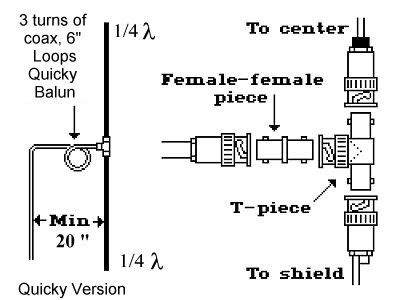All you need is 2 pieces of wire 3 insulators and a suitable feed line.
1 2 wave dipole calculator.
Use 75 or 50 ohm cable to feed the centre of the dipole.
1 2 wave dipole calculator.
Enter the frequency in mhz.
This could be 50 ohm types such as rg58 rg8x rg8 rg213 or 75 ohm type such as rg11 rg59 rg6 or even 75 ohm twin lead.
A 1 2 wavelength dipole is made up of two pieces of wire each 1 4 wavelength long.
Place a 1 1 balun on the antenna end of the feedline.
To make it even easier you can calculate the lengths of wire required to construct a 1 2 wave dipole using this page.
The measurements below are for building a simple dipole antenna.
Just grab a calculator and perform the following bit of division.
The radiating element is a quarter wave λ 4 and the radials are 12 longer.
The larger the wire the wider the bandwidth.
The inverted vee antenna legs will be longer by 2 6 from those of the horizontal antenna depending on the angle.
The half wave dipole is very simple to construct.
Calculating the lengths of the 1 2 wavelength wires is simple.
For a dipole or inverted vee antenna.
Even zip cord such as what is used for lamp cords will perform quite well.
The wire size can range from 16 awg to 12 awg.
Length feet 468 frequency mhz.
The distance between one point to another adjacent point in a wave is known as the wavelength.
This works very well with 18 to 12 wire sizes.
The basic formula for determining the wire length of a center fed 1 2 wave wire dipole or inverted vee antenna 30 mhz or less is 468 freq in mhz for feet and inches or 143 freq in mhz for meters.
The old standby formula 468 freq in mhz total length is used in the calculator for an average height of 1 2 wave high and horizontal dipole and then 5 is subtracted from that number to get the inverted v lengths.
There are usually four radials three being a minimum but you could use up to six.
The impedance of this antenna is around 300 ω so you may want to use a transformer or a λ 4 long piece of 120 ω coaxial cable to match this impedance to 50 ω.
This calculator uses a k multiplying factor value of 975 to adjust for the effect of antenna wire diameter on length which is applied to the free space half wavelength equation.
The antenna is designed to be fed with 50 or 75 ohm coax cable of most any length with a balun.
The dipole antenna is probably the easiest to make.

